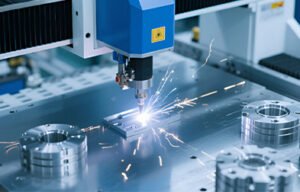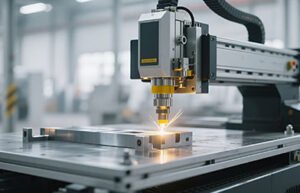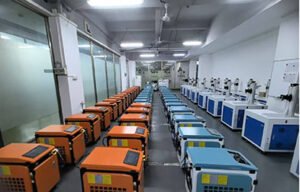- Home
- »
- Uncategorized
- »
- Why More Batter…
BLOG
CONTACT US
Why More Battery Manufacturers Choose Fiber Laser Welding?
1. Introduction
As demand for electric vehicles, energy storage systems, and portable electronics continues to surge, battery manufacturers are under increasing pressure to improve production speed, reduce defects, and maintain superior quality. One technology that is rapidly becoming the go-to solution for these challenges is fiber laser welding.
This article explores why more battery manufacturers around the world are switching to fiber laser welding for their production lines and how it is revolutionizing the way batteries are made.
2. The Demands of Modern Battery Manufacturing
Modern battery manufacturing involves high volumes, strict safety requirements, and extremely tight tolerances. Manufacturers of lithium-ion batteries, battery packs, and energy storage systems face several critical challenges:
Need for miniaturization of components
High production speed with low rejection rates
Resistance to thermal damage
Clean, non-contact welding processes
Compatibility with automated assembly lines
Fiber laser welding addresses each of these challenges, making it an ideal choice for the battery industry.
3. What Is Fiber Laser Welding?
Fiber laser welding is a non-contact welding method that uses a high-intensity fiber laser beam to join metal components. It provides concentrated energy that is ideal for thin, conductive, or sensitive materials, which are commonly used in batteries.
The fiber laser beam is delivered through an optical fiber, offering precise control, deep penetration, and minimal heat input. These features make it suitable for welding copper, aluminum, nickel, and stainless steel—typical materials in battery cell and pack assembly.
4. Advantages of Fiber Laser Welding in Battery Production
4.1 High Precision for Miniature Components
Battery cells and connectors are often just millimeters in size. Fiber laser welders provide pinpoint accuracy with laser spot sizes as small as 20 microns, allowing for clean, tight welds without affecting nearby areas.
4.2 Faster Welding Speed
Fiber lasers operate at high power densities, enabling welding speeds up to 10 times faster than traditional TIG or resistance welding. This dramatically boosts productivity in high-volume battery production.
4.3 Excellent Weld Quality and Consistency
With fiber laser welding, manufacturers achieve uniform, repeatable results. Welds are strong, clean, and free from cracks or porosity, which enhances battery reliability and life cycle.
4.4 Minimal Thermal Distortion
Battery materials are sensitive to heat. The low heat input of fiber lasers ensures minimal thermal impact, preventing deformation or damage to battery components.
4.5 Compatibility with Automation
Fiber laser welders are easily integrated with robotic arms, vision systems, and CNC platforms, supporting fully automated welding cells for high-efficiency production lines.
5. Typical Battery Components That Use Fiber Laser Welding
Fiber laser welding is used throughout the battery assembly process, including:
Battery tabs (aluminum, nickel, copper)
Busbars and connectors
Cylindrical and prismatic cell enclosures
Battery module and pack welding
Sealing of battery cans and covers
Current collectors and terminals
These components require reliable and precise joins, making fiber lasers the preferred technology.
6. Comparison with Other Welding Methods
| Feature | Fiber Laser Welding | Resistance Welding | Ultrasonic Welding | TIG Welding |
|---|---|---|---|---|
| Speed | Very High | Moderate | High | Low |
| Heat Input | Low | Medium | Low | High |
| Precision | Very High | Moderate | High | Moderate |
| Automation | Excellent | Good | Good | Limited |
| Maintenance | Low | High | Medium | High |
| Material Versatility | Excellent | Limited | Limited | Good |
Fiber laser welding consistently outperforms older methods in battery manufacturing, especially in efficiency and automation readiness.
7. Industry Case Studies: Fiber Laser Welding in Battery Production
Case 1: Electric Vehicle Battery Packs
Case 2: Consumer Electronics Batteries
8. Recommended Fiber Laser Welding Machines for Battery Manufacturers
At JOYLASER, we recommend the following models for battery-related applications:
Platform Fiber Laser Welding Machine: Ideal for precision busbar and cell welding with programmable XYZ motion control.
Galvanometer Fiber Laser Welder: Suitable for high-speed tab welding with dynamic focusing capabilities.
Integrated Fiber Laser Welding System with Automation: Perfect for large-scale pack production, compatible with robotic handling systems.
Each model is designed for high reliability, speed, and adaptability in battery assembly lines.
9. Key Considerations When Choosing a Fiber Laser Welder
To select the right fiber laser welding machine, battery manufacturers should consider:
Material type and thickness (copper, aluminum, nickel)
Welding joint design (overlap, fillet, butt)
Power requirements (1kW–3kW typically)
Cooling and stability
Automation compatibility
Vision system integration
After-sales service and global support
Working with a reliable supplier like JOYLASER ensures tailored solutions and continuous technical support.
10. Future Trends in Battery Manufacturing and Laser Technology
The evolution of solid-state batteries, higher energy density designs, and sustainable manufacturing will further increase the demand for fiber laser welding. As new materials and complex designs emerge, fiber laser welding will remain at the forefront due to its adaptability and precision.
Additionally, AI-assisted laser systems, real-time monitoring, and smart factory integration will enhance process control and product quality.
11. Conclusion
Fiber laser welding is no longer just an option—it has become a strategic necessity for battery manufacturers who aim for efficiency, precision, and scalability. Whether you’re producing lithium battery cells for EVs, packs for energy storage systems, or compact batteries for electronics, fiber laser welding delivers unmatched advantages in speed, quality, and cost-effectiveness.
By adopting fiber laser technology today, manufacturers position themselves for future success and industry leadership.
111-1024x458.png)


